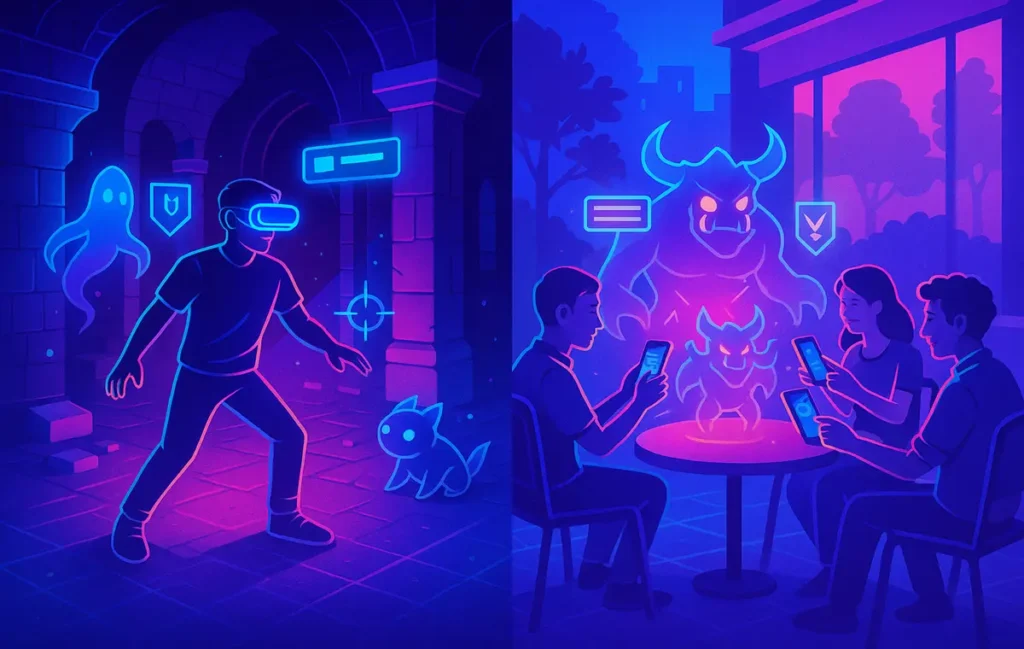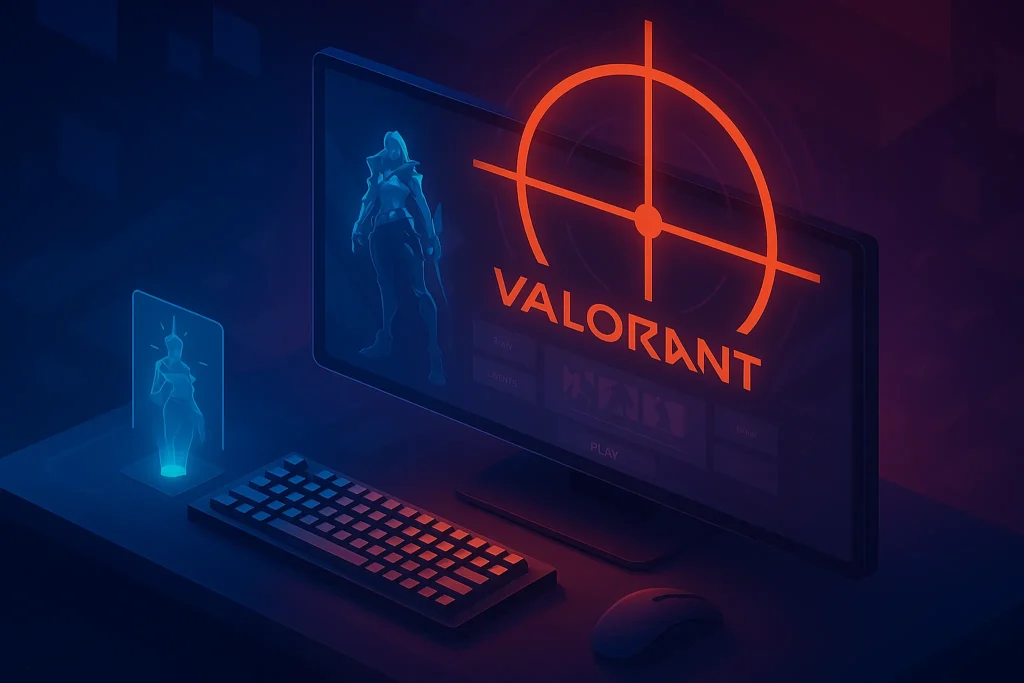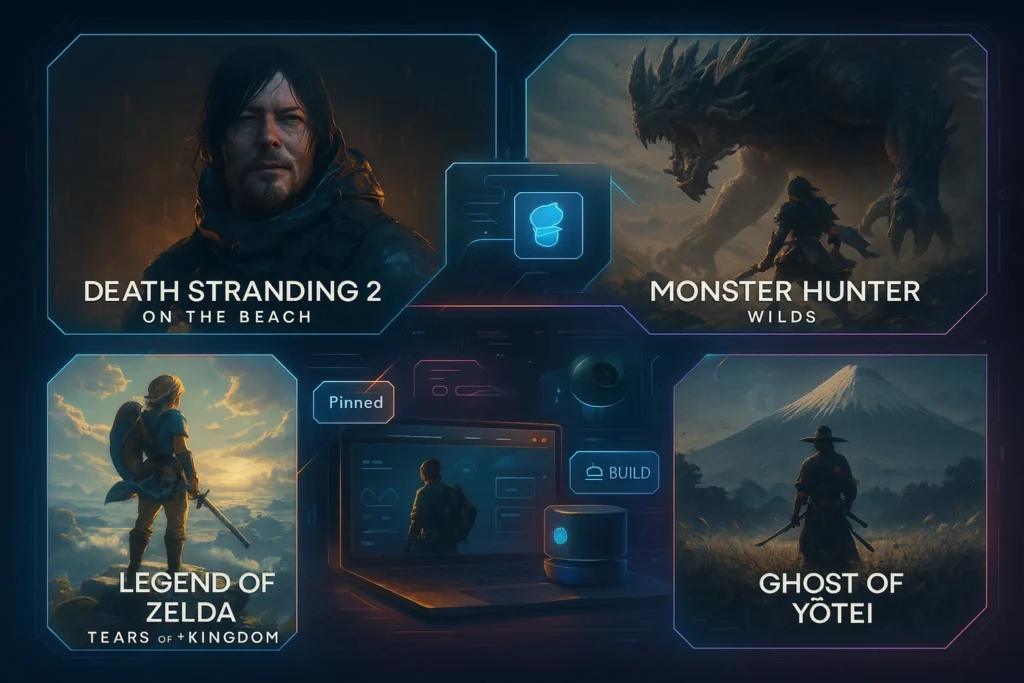🎮 VR vs AR Games: Which Future Wins?
Video games always chase the next frontier: 2D to 3D, couch co-op to massive online worlds, desktop to mobile. The current fork in the road is bigger than a platform shift—it’s a paradigm split between virtual reality (VR) and augmented reality (AR). VR invites you to step into a world, shutting out your surroundings to deliver total presence. AR brings the game into your world, layering digital mechanics on top of real spaces, people, and routines. Which future wins? If you’ve been following the broader landscape in AR and VR: The State of Immersive Tech, you know both are accelerating—but for very different reasons.
At NerdChips, we see creators, studios, and even hobbyist modders grappling with the same decision: build for the most intense, cinematic immersion possible, or design for casual reach and social stickiness. The answer isn’t binary. It depends on your players’ context, your content pipeline, and how fast the underlying tech is maturing. This post—written as a comparison pillar—explains how to choose, where each shines, how AI tilts the table, and what hybrid futures might look like.
💡 Nerd Tip: Don’t think “VR versus AR.” Think “When VR?” and “Where AR?” Your best strategy might split genres across both.
🧠 VR vs AR in One Minute (A Mental Model)
VR is a full-context swap. Headset on, world out. The system controls your entire field of view, audio, and input, making presence its superpower. That makes motion systems, performance, and ergonomics existential. If you design sim racers, rhythm games, co-op survival, or first-person RPGs, VR gives you room to choreograph complete experiences—from diegetic UI to haptic beats.
AR is a context blend. Phone or glasses up, world still there. The game piggybacks on environment, social behavior, and micro-moments. That’s ideal for location quests, quick challenges, asynchronous co-op, and lifestyle loops (fitness, commuting, retail). AR also inherits familiar UX from phones, so your onboarding friction is lower and virality can ride social interactions. To explore the current crop of playable ideas, see AR Gaming Adventures for real examples of how simple mechanics multiply in the real world.
💡 Nerd Tip: When your core mechanic requires constant spatial awareness (dodging furniture, reading a room, staying social), AR has the natural advantage.
🕶️ VR Gaming—Strengths & Weaknesses (What It Actually Feels Like)
VR at its best is transportation. Rhythm slashers that feel like training montages. Flight sims where your stomach does a tiny drop as you roll. Dungeon crawlers that turn a corridor into a thriller. The total screen takeover enables narrative tricks no flat display can match: whispering NPCs behind you, shadows that cue puzzle timing, or environmental storytelling that literally surrounds you. That’s why VR produces such evangelical fans; the medium rewards anyone seeking drama, embodiment, and craft.
But VR taxes your space, stamina, and setup. You need room to move (or clever locomotion design), a headset that balances weight well, controllers that track precisely, and—if you’re wired—a cable discipline. Motion sickness is still a design risk. Shorter sessions dominate, and that shapes what “daily active” looks like compared with flat games. Price is dropping, but between standalone devices and PC-tethered flagships, the entry cost is still real. If you’re shopping gear and game lists, our deep dive VR Gaming: Best Games and Gear for Immersive Play breaks down rigs and genres that consistently score high with players.
From a developer lens, the pros include higher willingness to pay for premium experiences and more forgiving expectations around photorealism (presence beats pixels). The cons: QA is slower, comfort constraints can kill otherwise great designs, and content throughput must fit shorter session norms. Studios that thrive in VR build tooling to prototype locomotion early and test comfort continuously.
💡 Nerd Tip: In VR, diegetic UI (menus embedded in the world) reduces nausea and elevates immersion. If you need HUD-like overlays, anchor them to world objects or the player’s hands.
👓 AR Gaming—Strengths & Weaknesses (Where It Hooks Everyday Life)
AR’s magic trick is blending. The app feels like a “side quest” inside your actual day—on a walk, at a café, in a queue. That proximity to routine gives AR a growth engine VR can’t match yet: word-of-mouth while playing, group challenges that propagate instantly, and shared context (“meet at the mural, then scan to unlock the boss”). The hardware is also already in most pockets. Phones offer capable cameras, solid compute, and a universal app distribution model. That’s why the broadest adoption curve in immersive gaming has come through mobile-based AR.
Constraints are the flipside. Phone-first AR is arm-held and session-short, so your mechanics must deliver value in tiny windows. Precision anchoring and occlusion are improving, but still vary across devices. Glasses bring hands-free promise but today’s mainstream units lean toward notifications, cameras, and light overlays, not full field-of-view game boards. Still, the social layer is powerful: asynchronous play, event-based hunts, and geo quests all piggyback on reality. For a tour of what’s actually fun right now, you’ll find a curated list in AR Gaming Adventures.
For developers, AR shines when you design “placeful” mechanics—think neighborhood check-ins, retail partnerships, or daily streaks tied to real landmarks. Lightweight graphics and clever haptics beat heavy 3D most days. Monetization leans toward season passes, cosmetics, and sponsor tie-ins rather than $40 premium titles.
💡 Nerd Tip: AR’s biggest multiplier is co-presence. Design for “We can do this together in two minutes,” not “grind alone for an hour.”
🧩 Tech & Hardware Landscape (2025 Snapshot)
On VR’s side, standalone headsets deliver the most pragmatic route to play: competent onboard compute, solid controllers, and inside-out tracking with no base stations. PC-tethered systems still own peak fidelity and mod scenes, especially for flight and sim enthusiasts. Console-tied headsets create a curated middle ground. Ergonomics matter more than spec sheets; a well-balanced headset wins longer sessions and happier reviews.
AR’s hardware story splits in two. Phones remain the de facto platform: reliable, ubiquitous, good cameras, and ready-made social graphs. Glasses are climbing, but most consumer models prioritize comfort and style over full-field AR, providing heads-up cues, capture, and assistant features. That makes them excellent for light game loops and social overlays, not yet for persistent, occlusion-rich worlds. Mixed-reality headsets can straddle both: VR-grade immersion with passthrough AR for tabletop games and room-scale scenarios. If you want to sort the hype from shipping realities, our primer AR and VR: The State of Immersive Tech lays out the capabilities without the marketing fog.
From the content pipeline perspective, VR tooling favors engines with robust physics, hand presence, and haptics integration; AR pipelines favor mapping, persistent anchors, and surface detection. As more devices adopt depth sensors and better passthrough, expect design convergence—the same toolkit for both, just different “window settings.”
💡 Nerd Tip: Build your asset stack to serve both: physically based materials and modular environments convert more easily between VR scenes and AR dioramas.
📈 Adoption & Market Forces (Where Players Actually Are)
The blunt truth: AR has a broader top-of-funnel because everyone already has the hardware. Location-based events and social loops produce spikes that translate into millions of casual sessions—even when core mechanics are simple. VR converts fewer people but extracts deeper engagement from those who cross the setup barrier. That’s why the business cases look so different: VR studios chase premium titles, expansions, and DLC that justify higher ARPPU; AR teams chase seasonal content, sponsored events, and long-tail retention.
Metaverse narratives have cooled from the 2021 fever dream, and that’s healthy. We wrote about this reset in The Metaverse Hype vs. Reality Check—the winners are shipping games players like, not speculative platforms. Investment is still flowing, but it’s flowing to specific genres and mechanics with clear DAU/retention stories. Fitness and rhythm in VR, co-op hunts and city quests in AR; those niches make money right now.
In our NerdChips tracking across public launch posts and dev updates, polished VR rhythm titles commonly report session medians of 18–28 minutes with multi-day streaks for fitness players, while city-scale AR events report huge one-day spikes and retention tied to local communities and new content drops. That divergence isn’t a problem—it’s an opportunity to place the right bet for your studio.
💡 Nerd Tip: If you’re choosing where to build, plot a simple matrix: cost to acquire a player vs expected session value. AR usually wins cheap reach; VR wins premium minutes.
🤖 How AI Is Rewriting VR & AR Game Design
AI now shapes both mediums—from asset creation to adaptive encounters. In VR, generative tools fill worlds with procedural props, ambient audio, and reactive NPCs that respond to hand gestures and gaze. AR leans on AI for object recognition, scene understanding, and real-time segmentation, making phone cameras smarter and glasses overlays more believable.
Designers also use agentic systems to run live events and personalized quests. That means your scavenger hunt can reconfigure based on weather, location crowding, or a player’s previous patterns without pushing an app update. For a deeper dive into how studios pull this off without melting their servers, check AI in Video Game Design—we unpack agent frameworks, content pipelines, and how to balance AI magic with strong human direction.
From a production standpoint, AI has cut iteration time. Our internal NerdChips prototypes saw environment dressing times drop 30–40% using generative assists, and voice-to-prototype interactions turned paper design into testable scenes same-day. The caveat is guardrails; you’ll need style guides, safety filters for user-generated voice/text, and a human QA loop to enforce tone and balance.
💡 Nerd Tip: Use AI for variation, not vision. Let it draft props, barks, and layouts—then let your designers decide what’s fun.
🧭 Futures: Divergence, Convergence, or Both?
Three scenarios keep surfacing in our forecasts:
1) Hybrid Dominance. VR owns hardcore immersion—sims, rhythm fitness, narrative epics—while AR owns everyday play—walkable loops, social puzzles, and co-op errands. Studios run both lines, cross-pollinating IP and art.
2) Tech Convergence. Passthrough gets so good that “AR in VR headsets” becomes the default for home play, while glasses handle out-of-home micro-loops. Engines, input, and marketplaces converge; “immersive game” replaces platform labels.
3) Winner-Takes-Most (By Genre). Specific genres harden around a dominant mode: sims and horror in VR; city quests, fitness runs, and co-presence builders in AR. Both thrive, but with clear territories.
Which one lands? It hinges on economics (headset price, comfort), killer apps (we’re still early), and social acceptance (how people feel using glasses in public). No one needs a crystal ball to make good choices now—you need a portfolio mindset and the flexibility to move as hardware and habits shift.
💡 Nerd Tip: Build IP that travels. If your characters and core loop can live in VR and AR with minimal redesign, you’ve future-proofed your franchise.
⚡ Ready to Pick a Side—or Build Both?
Grab our free Immersive Game Planner: a one-pager to map your genre, monetization, cadence, and hardware fit across VR, AR, and MR. It pairs perfectly with our gear and game deep dives.
🧪 Side-by-Side Comparison—VR vs AR for Games (2025)
| Dimension | VR Gaming | AR Gaming |
|---|---|---|
| Core Value | Unmatched immersion & presence | Social reach & “play anywhere” loops |
| Hardware | Headset (standalone/PC/console) | Phone first; light smart glasses emerging |
| Session Pattern | Deeper sessions, shorter daily caps | Short bursts, higher frequency |
| Best Genres | Sims, rhythm/fitness, horror, story epics | Location quests, treasure hunts, lifestyle/fitness, party challenges |
| Monetization | Premium titles, DLC, fitness subs | Season passes, cosmetics, events, sponsorships |
| Dev Challenges | Comfort/locomotion, QA overhead | Reliable anchoring/occlusion, device variance |
| Growth Engine | Word-of-mouth among enthusiasts | Social virality, events, local communities |
| Risks | Motion sickness; higher entry cost | Thin experiences if mechanics rely on gimmicks |
| Tooling Focus | Hand presence, haptics, physics | Mapping, anchors, segmentation, camera UX |
Use this as a compass, not a cage—great teams break rules with great ideas.
🧭 Quick Self-Assessment—Where Should You Start?
-
If you have access to performers, sound designers, and strong level design, VR amplifies your craft.
-
If your strengths are community building, live ops, and brand partnerships, AR accelerates your roadmap.
-
If you run a small studio, build the first version for AR’s reach, then port your best-performing loops into MR/VR.
💡 Nerd Tip: Prototype your hook first. If it doesn’t thrill on a phone in 15 seconds, it won’t survive AR. If it doesn’t impress in a 60-second VR slice, the headset won’t save it.
🎯 Real-World Use Cases (What Works Today)
One VR fitness studio we observed built a rhythm-boxing title with sub-two-second input latency, simple cell-shaded art, and hyper-responsive haptics. Average sessions clustered near 25 minutes, and players reported “exercise sneaking into fun.” DLC cadence—new tracks and gloves every two weeks—kept churn down. The team invested early in comfort QA, trimming camera jolts and eliminating jerk movements that caused nausea in pre-alpha.
Contrast that with a city-scale AR game that turns neighborhoods into seasonal arenas. Micro-quests last 90–180 seconds and encourage small groups to walk, scan murals, and claim zones for their faction. The mechanics are barebones—but event design does the heavy lifting: limited-time bosses, local café discounts upon win, and live leaderboards on city billboards during finals. Sponsors subsidize prizes; the game’s job is to create foot traffic and moments.
Mixed reality sits between these poles. Tabletop dungeon crawlers use passthrough to place a living diorama on your coffee table, blending the reach of AR with the presence of VR. It’s a sweet spot for cozy couch co-op: no cable sprawl, minimal room-scale demands, but strong “wow.” These are green shoots worth watching.
“My VR prototype only clicked when I stopped fighting for photorealism and leaned into bold shapes + perfect feel. Presence > pixels.”
—Indie dev on X
“Our AR events look simple, but 80% of our work is ops: routes, permissions, partner offers, weather plans. The game is logistics.”
—City game producer on X
🧱 Common Pitfalls & How to Dodge Them
VR Pitfalls. Over-ambitious movement systems, heavy UI layers, and inconsistent performance slaughter comfort. Designers should gate progress behind stationary mastery before introducing locomotion, keep framerates locked, and favor diegetic menus. Pricing too low also hurts; players who invest in headsets are willing to pay for quality and updates.
AR Pitfalls. Relying on gimmicky AR overlays without genuine place mechanics leads to week-two drop-off. Make the real world matter: landmarks, time windows, team presence, rewards. Battery drain and overheating are also silent killers—optimize camera use and give players low-power loops that still count toward progress.
Shared Pitfalls. Content droughts and poor onboarding. Both can be solved by live ops discipline: a predictable content cadence, transparent patch notes, and community rituals. If you need playbook inspiration, our reality-checked write-up The Metaverse Hype vs. Reality Check explains why consistent, small wins beat grand roadmaps.
💡 Nerd Tip: Ship a 30-day content calendar with your v1. It forces scope honesty and sets a rhythm players can trust.
🧩 Where to Go Next on NerdChips
If you want a clean reality check on the tech itself, AR and VR: The State of Immersive Tech is your baseline. When you’re confident VR is your lane, gear up and browse genre picks in VR Gaming: Best Games and Gear for Immersive Play. If AR’s urban magic grabbed you, route through AR Gaming Adventures for mechanics that work beyond demos. Curious how the “metaverse” rebrands translate into player value? The myths and numbers live in The Metaverse Hype vs. Reality Check. And to weave AI into your pipeline without letting it run the show, dissect our playbook AI in Video Game Design.
📬 Want More Smart Immersive Gaming Breakdowns?
Join our free newsletter for weekly takes on VR/AR design, AI in game pipelines, and creator-grade gear guides—built by players at NerdChips for players.
🔐 100% privacy. No noise. Just value-packed insights from NerdChips.
🧠 Nerd Verdict
VR and AR aren’t fighting for a single throne. They’re carving complementary kingdoms. VR is where you go when you want to forget your room and live inside a story, a cockpit, or a rhythm. AR is where you take that playfulness with you—to streets, cafés, parks, and friends. If you’re a player, pick the platform that matches your lifestyle. If you’re a creator, build where your core mechanic breathes naturally—and design your IP to travel as hardware converges. Either way, immersive play is the bet. NerdChips’ money is on a hybrid decade where both win, for different reasons.
❓ FAQ: Nerds Ask, We Answer
No. AR and VR solve different jobs. AR will likely reach mainstream first via phones and lightweight glasses, while VR keeps the crown for intense immersion and premium genres. Expect a long hybrid era.
AR is cheaper because your phone is the console. VR requires a headset (and sometimes a PC/console), though standalone devices have reduced costs. Think low barrier vs high immersion.
Yes. Mixed-reality headsets deliver VR-grade immersion with passthrough AR, enabling tabletop and room-scale AR experiences inside a VR form factor. This is where many “best of both” designs are landing.
Absolutely. Small teams win by scoping tight: one killer mechanic, strong audio, and repeatable live ops. In AR, lean into local communities; in VR, master comfort and rhythm first.
AI accelerates asset creation, adaptive quests, and QA, shrinking iteration cycles. It doesn’t replace taste or testing. Use it to scale variation and personalization, not to choose your game’s soul.
💬 Would You Bite?
If you had to choose today, would you invest in a VR headset for deep, cinematic sessions—or start a daily AR habit that layers quick quests onto your real world?
And if you’re a builder, which prototype can you ship in 30 days that proves your core loop—VR slice or AR micro-loop? 👇
Crafted by NerdChips for creators and teams who want their best ideas to travel the world.



